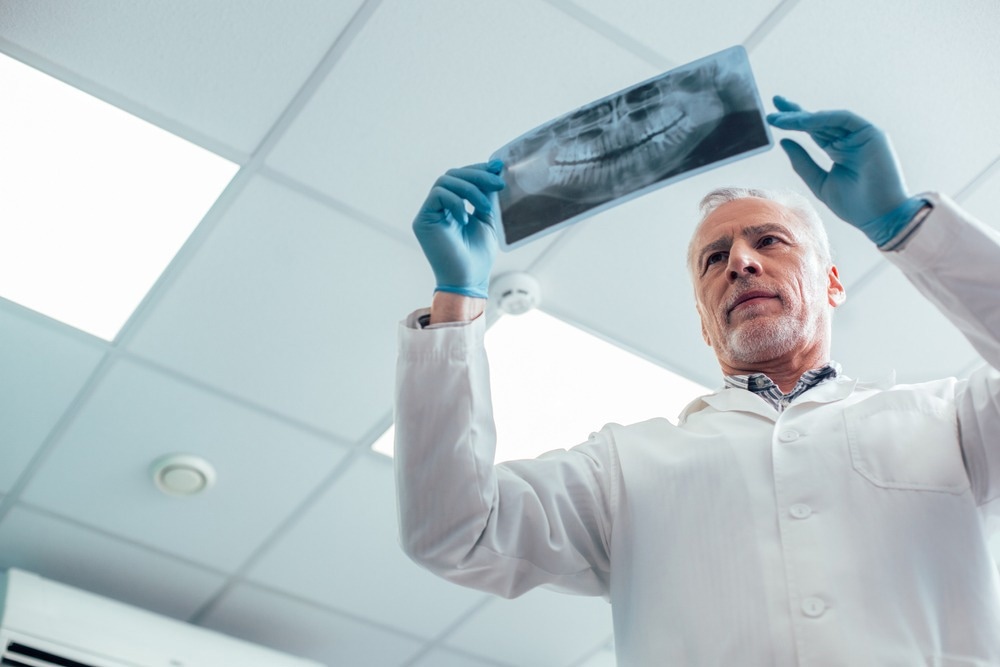A study published in Applied Sciences compared fluorescence‐aided identification with conventional light illumination technique with respect to time, accuracy, and professional experience required for dental composite remnants detection after trauma splint removal.

Study: Accuracy of the Fluorescence‐aided Identification Technique (FIT) for detecting residual composite remnants after trauma splint removal—a laboratory study. Image Credit: AndriyShevchuk/Shutterstock.com
Splinting Of Teeth Following Trauma
Dental injuries are common among children and teenagers. Some injuries, such as root fractures and luxation of permanent teeth, necessitate splinting after replantation or repositioning of the tooth.
The duration of splinting depends on the nature of the injury. In most situations, the splint is removed after four weeks. However, following some injuries, including root fractures, it can take approximately 12 weeks.
It is becoming increasingly important for afflicted individuals that tooth splinting be as inconspicuous as practicable. As a result, the titanium trauma splint (TTS) comes with a matte surface and attaches to the tooth using a tooth-colored composite.
It is a flexible, simple device that complies with current aesthetic requirements and adjusts according to the dental arch. The matte silver titanium trauma splint comprises rhombuses that cross one another and include openings for the placement of composite resin materials that will affix the splint to the teeth.
The titanium trauma splint is made indistinguishable using a tooth-colored composite; however, this makes its removal quite challenging due to the seamless appearance of the transition from the composite to the enamel.
Effects of Composite After De-Bonding on the Enamel
Plaque retention areas and aesthetic damage from discolored composite margins, leading to permanent enamel demineralization, are the possible effects of composite remnants.
Composite remnants could weaken the bonding power of future adhesive restorations, which are frequently needed following dental trauma.
Titanium Trauma Splint (TTS) Removal Using the Fluorescence-Aided Identification Technique
Fluorescence-aided identification is a fast, reliable, and user-friendly non‐invasive diagnostic technique. It facilitates the detection and orthodontic bracket de-bonding of composite restorations in forensics.
Rare earth oxides and other fluorescent elements are incorporated into the glass fillings of composite resin materials to replicate the fluorescence properties of dentine and enamel. However, these restorative materials emit fluorescence at different wavelengths than typical tooth structures.
The fluorescence-aided identification technique exploits the various fluorescence characteristics of these restorative composite materials to make them look brighter than native tooth structures when exposed to fluorescent light.
Comparing Composite Detection Capability of Fluorescence-Aided Identification and Conventional Illumination Method
This study’s major objective was to compare the fluorescence-aided identification technique with the conventional illumination method for detecting composite remnants following trauma splint removal.
Data on the influence of examiner gender and experience on the accuracy, process time, retest-reliability, and inter-rater-reliability was gathered.
Ten tooth models were constructed, each depicting an upper and lower arch of a bovine’s teeth. Ten dental students and ten professional dentists evaluated these models using a dental unit lamp and a fluorescence‐inducing headlamp for conventional illumination and fluorescence-aided identification, respectively.
Examiners mapped the location of recognized composite remnants and recorded the time required for each technique. The significance level for the statistical analysis was set α = 5% using the R 3.2.2 program.
Significant Findings of the Study
Fluorescence-aided identification was more precise and required less time than the conventional illumination method (p<0.001). In addition, the dentist’s professional expertise does not influence the fluorescence-aided identification technique’s accuracy and process time.
The examiner’s gender is known to affect the quality of color shade matching, although it did not affect this study’s results. There were no statistically significant variations in accuracy between students and professional dentists.
Contrary to expectations, dental students executed the fluorescence-aided identification procedure substantially faster than dentists. Although the difference in process duration was statistically significant, it is highly unlikely to be clinically useful. In addition, the findings of the inter-rater reliability test revealed a clear consensus among the examiners.
Furthermore, the fluorescence-aided identification procedure does not require any tooth drying, in contrast to the regular tooth drying required during the removal of composite residues under conventional light illumination. This has substantial therapeutic implications since continuous drilling and drying lengthens the treatment.
High fluorescence nature of the composite material and bovine teeth allowed for a consistent research procedure. However, the use of non-human teeth greatly deviates from the clinical setting, which may have affected the results.
Reference
Magni, E., Leontiev, W., Soliman, S., Dettwiler, C., Klein, C., Krastl, G., Weiger, R., & Connert, T. (2022) Accuracy of the Fluorescence‐aided Identification Technique (FIT) for detecting residual composite remnants after trauma splint removal—a laboratory study. Applied Sciences. https://www.mdpi.com/2076-3417/12/19/10054
Disclaimer: The views expressed here are those of the author expressed in their private capacity and do not necessarily represent the views of AZoM.com Limited T/A AZoNetwork the owner and operator of this website. This disclaimer forms part of the Terms and conditions of use of this website.